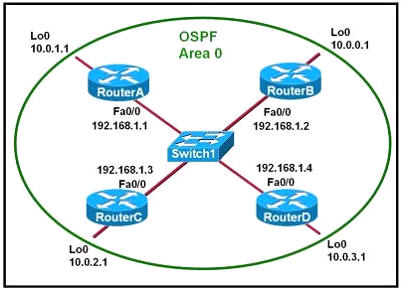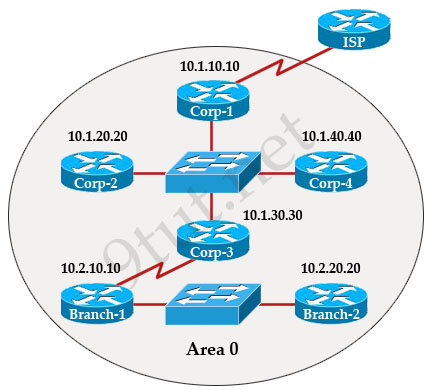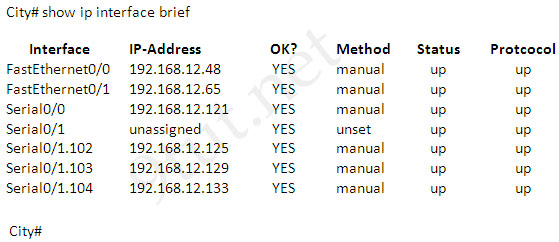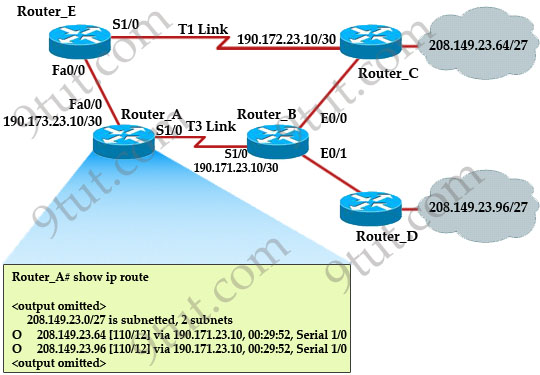CCNA – OSPF Questions 2
Here you will find answers to OSPF Questions – Part 2
Note: If you are not sure about OSPF, please read my OSPF tutorial
Question 1
Refer to the exhibit. Which two statements are true about the loopback address that is configured on RouterB? (Choose two)

A. It ensures that data will be forwarded by RouterB.
B. It provides stability for the OSPF process on RouterB.
C. It specifies that the router ID for RouterB should be 10.0.0.1.
D. It decreases the metric for routes that are advertised from RouterB.
E. It indicates that RouterB should be elected the DR for the LAN.
Answer: B C
Explanation
A loopback interface never comes down even if the link is broken so it provides stability for the OSPF process (for example we use that loopback interface as the router-id) -> B is correct.
The router-ID is chosen in the order below:
+ The highest IP address assigned to a loopback (logical) interface.
+ If a loopback interface is not defined, the highest IP address of all active router’s physical interfaces will be chosen.
-> The loopback interface will be chosen as the router ID of RouterB -> C is correct.
Question 2
Which characteristics are representative of a link-state routing protocol? (Choose three)
A. provides common view of entire topology
B. exchanges routing tables with neighbors
C. calculates shortest path
D. utilizes event-triggered updates
E. utilizes frequent periodic updates
Answer: A C D
Explanation
Each of routers running link-state routing protocol learns paths to all the destinations in its “area” so we can say A is correct although it is a bit unclear.
Link-state routing protocols generate routing updates only (not the whole routing table) when a change occurs in the network topology so B is not correct.
Link-state routing protocol like OSPF uses Dijkstra algorithm to calculate the shortest path -> C is correct.
Unlike Distance vector routing protocol (which utilizes frequent periodic updates), link-state routing protocol utilizes event-triggered updates (only sends update when a change occurs) -> D is correct but E is not correct.
Question 3

The internetwork infrastructure of company XYZ consists of a single OSPF area as shown in the graphic. There is concern that a lack of router resources is impeding internetwork performance.
As part of examining the router resources the OSPF DRs need to be known.
All the router OSPF priorities are at the default and the router IDs are shown with each router.
Which routers are likely to have been elected as DR? (Choose two)
A. Corp-1
B. Corp-2
C. Corp-3
D. Corp4
E. Branch-1
F. Branch-2
Answer: D F
Explanation
There are 2 segments on the topology above which are separated by Corp-3 router. Each segment will have a DR so we have 2 DRs.
To select which router will become DR they will compare their router-IDs. The router with highest (best) router-ID will become DR. The router-ID is chosen in the order below:
+ The highest IP address assigned to a loopback (logical) interface.
+ If a loopback interface is not defined, the highest IP address of all active router’s physical interfaces will be chosen.
In this question, the IP addresses of loopback interfaces are not mentioned so we will consider IP addresses of all active router’s physical interfaces. Router Corp-4 (10.1.40.40) & Branch-2 (10.2.20.20) have highest “active” IP addresses so they will become DRs.
Question 4

A network associate has configured OSPF with the command:
City(config-router)# network 192.168.12.64 0.0.0.63 area 0
After completing the configuration, the associate discovers that not all the interfaces are participating in OSPF.
Which three of the interfaces shown in the exhibit will participate in OSPF according to this configuration statement? (Choose three)
A. FastEthernet0/0
B. FastEthernet0/1
C. Serial0/0
D. Serial0/1.102
E. Serial0/1.103
F. Serial0/1.104
Answer: B C D
Explanation
The “network 192.168.12.64 0.0.0.63″ equals to network 192.168.12.64/26. This network has:
+ Increment: 64 (/26= 1111 1111.1111 1111.1111 1111.1100 0000)
+ Network address: 192.168.12.64
+ Broadcast address: 192.168.12.127
Therefore all interface in the range of this network will join OSPF -> B C D are correct.
Question 5
When running OSPF, what would cause router A not to form an adjacency with router B?

A. The loopback addresses are on different subnets.
B. The values of the dead timers on the routers are different.
C. Route summarization is enabled on both routers.
D. The process identifier on router A is different than the process identifier on router
Answer: B
Explanation
To form an adjacency (become neighbor), router A & B must have the same Hello interval, Dead interval and AREA number.
Question 6
Refer to the exhibit. The network is converged. After link-state advertisements are received from Router_A, what information will Router_E contain in its routing table for the subnets 208.149.23.64 and 208.149.23.96?

A. 208.149.23.64[110/13] via 190.173.23.10, 00:00:00:07, FastEthernet0/0
208.149.23.96[110/13] via 190.173.23.10, 00:00:00:16, FastEthernet0/0
B. 208.149.23.64[110/1] via 190.173.23.10, 00:00:00:07, Serial1/0
208.149.23.96[110/3] via 190.173.23.10, 00:00:00:16, FastEthernet0/0
C. 208.149.23.64[110/13] via 190.173.23.10, 00:00:00:07, Serial1/0
208.149.23.96[110/13] via 190.173.23.10, 00:00:00:16, Serial1/0
208.149.23.96[110/13] via 190.173.23.10, 00:00:00:16, FastEthernet0/0
D. 208.149.23.64[110/13] via 190.173.23.10, 00:00:00:07, Serial1/0
208.149.23.96[110/13] via 190.173.23.10, 00:00:00:16, Serial1/0
Answer: A
Explanation
Router_E learns two subnets subnets 208.149.23.64 and 208.149.23.96 via Router_A through FastEthernet interface. The interface cost is calculated with the formula 108 / Bandwidth. For FastEthernet it is 108 / 100 Mbps = 108 / 100,000,000 = 1. Therefore the cost is 12 (learned from Router_A) + 1 = 13 for both subnets -> B is not correct.
The cost through T1 link is much higher than through T3 link (T1 cost = 108 / 1.544 Mbps = 64; T3 cost = 108 / 45 Mbps = 2) so surely OSPF will choose the path through T3 link -> Router_E will choose the path from Router_A through FastEthernet0/0, not Serial1/0 -> C & D are not correct.
In fact, we can quickly eliminate answers B, C and D because they contain at least one subnet learned from Serial1/0 -> they are surely incorrect.
Question 7
Refer to the exhibit. Given the output for this command, if the router ID has not been manually set, what router ID will OSPF use for this RouterD?
RouterD# show ip interface brief

A. 10.1.1.2
B. 10.154.154.1
C. 172.16.5.1
D. 192.168.5.316
Answer: C
Explanation
The highest IP address of all loopback interfaces will be chosen -> Loopback 0 will be chosen as the router ID.
Question 8
Which commands are required to properly configure a router to run OSPF and to add network 192.168.16.0/24 to OSPF area 0? (choose two)
A. Router(config)#router ospf 1
B. Router(config)#router ospf 0
C. Router(config)#router ospf area 0
D. Router(config-router)#network 192.168.16.0 0.0.0.255 area 0
E. Router(config-router)#network 192.168.16.0 0.0.0.255 0
F. Router(config-router)#network 192.168.16.0 255.255.255.0 area 0
Answer: A D
Explanation
In the router ospf
command, theranges from 1 to 65535 so o is an invalid number -> A is correct but B is not correct.
To configure OSPF, we need a wildcard in the “network” statement, not a subnet mask. We also need to assgin an area to this process -> D is correct.
Question 9
Which parameter or parameters are used to calculate OSPF cost in Cisco routers?
A. Bandwidth, Delay and MTU
B. Bandwidth
C. Bandwidth and MTU
D. Bandwidth, MTU, Reliability, Delay and Load
Answer: B
The well-known formula to calculate OSPF cost is
Cost = 108 / Bandwidth
so B is the correct answer.
Question 10
Refer to the exhibit. Why are two OSPF designated routers identified on Core-Router?
| Neighbor_ID | Pri | State | Dead Time | Address | Interface |
| 208.149.23.194 | 1 | Full/DR | 00:00:33 | 190.172.32.10 | Ethernet1 |
| 208.149.23.60 | 1 | Full/BDR | 00:00:33 | 190.172.32.10 | Ethernet0 |
| 208.149.23.130 | 1 | Full/DR | 00:00:39 | 190.172.32.10 | Ethernet0 |
A. Core-Router is connected more than one multi-access network
B. The router at 208.149.23.130 is a secondary DR in case the primary fails.
C. Two router IDs have the same OSPF priority and are therefore tied for DR election
D. The DR election is still underway and there are two contenders for the role.
Answer: A
Explanation
OSPF elects one DR per multi-access network. In the exhibit there are two DR so there must have more than one multi-access network.
Question 11
What is the default maximum number of equal-cost paths that can be placed into the routing of a Cisco OSPF router?
A. 16
B. 2
C. unlimited
D. 4
Answer: D
Explanation
The default number of equal-cost paths that can be placed into the routing of a Cisco OSPF router is 4. We can change this default value by using “maximum-paths” command:
Router(config-router)#maximum-paths 2
Note: Cisco routers support up to 16 equal-cost paths. In detail, the default number of maximum paths is 32 for Cisco CRS-1 routers and 16 for Cisco XR 12000 Series Routers. The range is from 1 to 32 for Cisco CRS-1 routers and 1 to 16 for Cisco XR 12000 Series Routers.
(Reference: http://www.cisco.com/en/US/docs/ios_xr_sw/iosxr_r3.7/routing/configuration/guide/rc37ospf.html)
Question 12
What is the OSPF default frequency, in seconds, at which a Cisco router sends hello packets on a multiaccess network?
A. 10
B. 40
C. 30
D. 20
Answer: A
Explanation
On broadcast multiacess and point-to-point links, the default is 10 seconds. On NBMA, the default is 30 seconds.
Question 13
What is the default administrative distance of OSPF?
A. 120
B. 100
C. 90
D. 110
Answer: D
Question 14
What information does a router running a link-state protocol use to build and maintain its topological database? (Choose two)
A. hello packets
B. SAP messages sent by other routers
C. LSAs from other routers
D. beacons received on point-to-point links
E. routing tables received from other link-state routers
F. TTL packets from designated routers
Answer: A C



Inregards to Q6.
The main characteristc of OSPF is linkstate. Would it be correct to say that the main choice of route is base on link. The higher link the more preferable.
con’t…..OSPF always would choose T3 link over T1 link regardless. I hope am not too far off-course?
ANONYMOUS…
i know you are very active in these blogs..kindly can you explain q6 in full…im very confused like how did it calculate the “the number 13″
@ hammad
Ospf metric is called cost. The lower the cost, the more likely the interface is to be used to forward data traffic. Ospf uses bandwidth in calculating cost. The links between routers in ospf network may have different links at different cost based on the bandwidth.
Here are the interface types (Links) and the COST associated to these interface.
Fast Ethernet(Fa)……..cost is 1
Ethernet(E)…………….cost is 10
E1………………………cost is 48
T1………………………cost is 64
T3………………………cost is 2
128kbps……………….cost is 781
64kbps…………………cost is 1562
56kbps…………………cost is 1785
I hope this helps.
@ hammad…you have to look at the entire path from the subnet to the destination. Looking at Koffy’s chart, the path from the 208.149.23.96/27 travelled through an ethernet interface (cost 10) and then over an T3 WAN link (2), so Router A learned it with a cost of 12 (10+2). Sending the info to fa0/0 of Router E adds 1 more (because it’s fast ethernet), making the entire cost path 13.
Hope this helps!
please send me new Dumps i intend to write my CCNA exams this month end, i would greatly apriciate your efforts. send to my eamil malotonyirenda@yahoo.com
Q7…isn’t B the answer? why C?
@Pappy: 172 > 10 isn’t it? ))
In Question 2, I think the answers D and E are correct:
D. utilizes event-triggered updates
E. utilizes frequent periodic updates
Here is what it says about OSPF in the ICDN2 official cert guide:
“Neighbors in a Full state still do some maintenance work. They keep sending Hellos every Hello interval. … . Also, if any topology changes occur, the neighbors send a new copies of the changed LSAs to each neighbor”
So from what I understand OSPF uses frequent perioc updates AND event-triggered updates.
What do you think ?
@Matt: You are wrong. Hello packet routing update. These packets used to establish and maintain the neighborship relation with neighbor routers.
@Matt: Hello packet hasn’t any routing update information. These packets used to discover neighbors and to establish and maintain the neighborship relation with neighbor routers.
@DimS: ok I agree that hello packets aren’t sending routing table but the question doesn’t specify the type of update. hello packets are sending updates on neighbors.
@DimS: ok I agree that hello packets aren’t sending routing table but the question doesn’t specify the type of update. hello packets are sending updates on neighbors.
AFAIK: Hello packets don’t have any update info. It is like a “ping” to a neighbor:
R1: Hi! Are you still here?
R2: Yes, I’m here. And you?
R1: I’m here too.
can any body explain q-14
I guess it should be C and E???
whay can’t E at the starting they exchange the routing tables
Cisco Craze:
Hello packets are sent when the OSPF is first turned on, this lets the router find its neighbors so A is correct. (Also read the question it is talking about the topology table which is different from the routing table) second choice E routing tables received from other link-state routers is incorrect for forming a topology table. After Hello packets are exchange then OSPF sends LSA packets these two will form the topology table and let the router discover its neighbors.
Hope that helps
Hi Guys. Please do a brother a favour and e-mail me the latest dumps please. I failed today. :(
rameshseluras@rocketmail.com. Thanks
hi 9tut,
in the latest pass4sure answer of Q3 is E, F that is Brach1 and Branch 2. Which is correct ?
hi every one
Question 8
Which commands are required to properly configure a router to run OSPF and to add network 192.168.16.0/24 to OSPF area 0? (choose two)
A. Router(config)#router ospf 1
B. Router(config)#router ospf 0
C. Router(config)#router ospf area 0
D. Router(config-router)#network 192.168.16.0 0.0.0.255 area 0
E. Router(config-router)#network 192.168.16.0 0.0.0.255 0
F. Router(config-router)#network 192.168.16.0 255.255.255.0 area 0
Answer: A D
if it is back bone router we have to configure as ospf 0 it can also b a answer \
@anonymous
“Router(config)#router ospf ?
Process ID”
the value must be from that range
@ Anonymous
xallax is right the range for the process id is 0 – 65535
if you are talking about areas is 0 to 4.2 billions but you will be on an incorrect prompt mode
@Liss: Incorrect: the range for OSPF pid = 1 – 65535.
So B will be incorrect answer.
so now let’s all draw a final conclusion here. is the process id range 0-65535 or 1-5535?
@lydia
“Router(config)#router ospf ?
[1-65535] Process ID”
1 – 65535
@lydia
Process ID: 1-65535
Area: 0-4294967295
we can’t assign 0 as the process ID, area 0 is fine it’s called backbone area.
CCNA test is getting very difficult!!!!!!!!!!!!!!!
@xallaX and fwz. thanx
Qn 3
Todd Lammle pg 471 says that the equivalent routers to select for CCNA exam is Branch1 and Branch2 and not Corp 4. What should be the correct answer?
For question above reference of Todd Lammle is the 6th edition, pg 471.
9tut
Question 6:
I think you have a typo for serial0/1 interface. I do believe that you meant to write 190.172.23.10 for those interfaces…
I should be more specific, that was for the answers. Not the diagram of the question.
On question 11, the note contains an error, maximum path is 16 not 6
@ ALL
Question : There are two networks A and B. A and B’s routers are running with RIP,EIGRP and OSPF protocols. IP – 172.16.5.0\28 is used in both networks.Auto summarizatio is turned ON. So in this case which protocol will the routers choose ?
@newbie
if the default administrative distances are used, the routers will choose EIGRP
@xallax
Can you please help.
This is regarding loopback ip address.
It says the highest loopback ip address automatically becomes DR regardless, cos is virtual, and never goes down.
My question is if it is “regardless” does the loopback ip address has to be the highest?
@koffy
this is the order:
1) router-id – this supersedes any other values and this becomes the ID this router for the OSPF area.
2) loopback address – the highest IP value of the loopback addresses configured on the router will be used as ID for the OSPF area.
3) interface address – if router-id is not set and there is no loopback configured then the router will choose the highest IP value as its ID.
the router does not become DR or BDR just because it has a loopback configured.
picture a small network with 5 routers that have loopbacks on each of them. all these 5 routers are connected to a switch. you will have a DR, a BDR and 3 non-designated.
“If no router is DR or BDR on a given subnet, the DR is first elected, and then a second election is held if there is more than one BDR.”
http://en.wikipedia.org/wiki/Open_Shortest_Path_First
@xallax
Thanks.
Which routers are likely to have been elected as DR? (Choose two)
A. Corp-1
B. Corp-2
C. Corp-3
D. Corp4
E. Branch-1
F. Branch-2
Answer is E & F, NOT D & F!!! The highest IPs for the given routers are 10.2.20.20 & 10.2.10.10. If you were to write the entire 32 bits out for 10.2.10.10 (00001010.00000010.00010100.00010100) > 10.1.40.40 (00001010.00000001.00101000.00101000). This proves that Branch-1 and Branch-2 will be the Designated Routers(DRs).
@Chad
u are wrong , 2 multiaccess zones, 1 DR per zone :
zone 1—>corp 4
zone 2 —>branch 2
if u understand the 2 diferentiated zones , u understand the correct answer
hi guys pliz advice im writing my ccna again which i failed on the 14th of september in 2days time, i just wana know if they will ask me the very same questions and simulations.some 1 told me that the more u fail the more tougher the exam gets because cisco does not want u to be familiar with it.thank u in advance
@Hellionz, where are you getting Zone 1 and Zone 2? So the serial connections determine that there are 2 multi-access zones? You can’t jump to a resolution without justifying your answer, so please explain.
why isn’t (cost for 208.149.23.23) 1+2+10+1=14
1 for Fa0/0 on RouterA
2 for T3
10 for E0/0 on RouterB
and 1 for interface of destination network ?
Thanks
why isn’t (cost for 208.149.23.64) 1+2+10+1=14
1 for Fa0/0 on RouterA
2 for T3
10 for E0/0 on RouterB
and 1 for interface of destination network ?
my mistake network is 208.149.23.64, not 208.149.23.23
Thanks
Please send the latest dump-taking the ICND-2 640-816 part 2 exam in 5 days. Thanks
pmckernan13@gmail.com
very nice 9tut
merci a 9tut pour tout le travail fait!
Q11, I think maximum equal-cost paths for EIGRP is 4 and OSPF is 16. Why the answer is not A?
@ppa
“maximum” and “default”
if it’s the maximum value then 16 would be true
if it’s only the default value then 4 would be true…
by default the number of equal-cost paths is 4.
i’d go for option D…
https://learningnetwork.cisco.com/thread/7910
@9tut
on Q11, there’s a typo in the explanation, please change 6 to 16
pls help me to explain the ans.qtn:3…..is there somethng like zone in single area……..